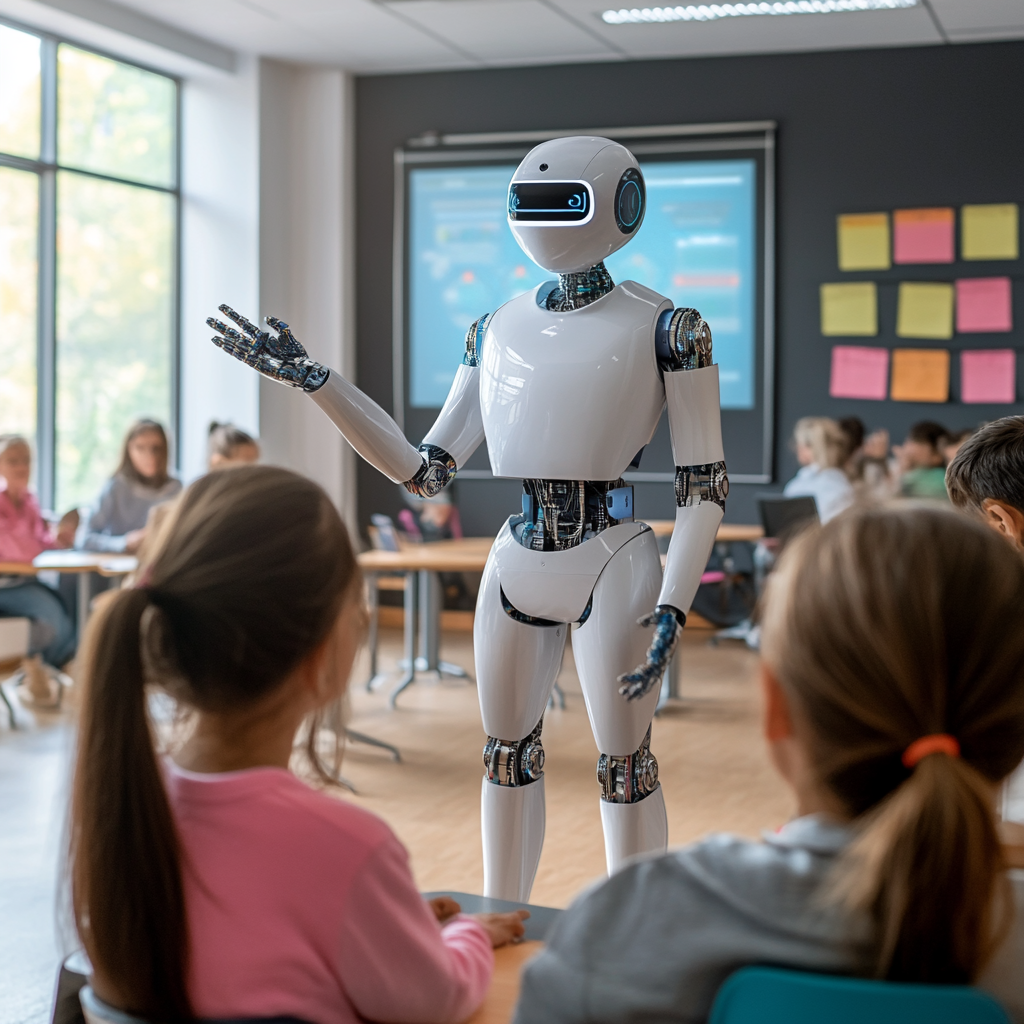The Reality: Students are Already Using AI So What Does This Mean for Teachers?
Students’ Use of AI Tools Is Widespread and Growing
Recent surveys show that students in K-12 schools use AI-powered tools regularly for assignments, research, and study help. According to a 2024 Pew Research Center report, about 25% of public K-12 teachers think AI does more harm than good, while around a third notice both positive and negative effects. Despite these mixed opinions, students continue to use AI more with each semester.
How Students Use AI: Real-World Examples
Students use AI in many ways, such as:
- Writing essay drafts or completing homework
- Translating text to learn new languages
- Solving math and science problems with step-by-step guidance
- Making presentations and visuals
A study from the University of Illinois shows that AI tools give instant and detailed feedback. This feedback helps students spot their strengths and areas for improvement faster than many traditional methods.
Implications for Teachers: Shifting Roles and New Demands
As more students use AI, teachers must adjust how they teach. Consider these changes:
- Instructional Design: Focus assignments on critical thinking, originality, and the learning process rather than just the final answer.
- Assessment Integrity: Develop new ways to check that students do their own work and follow academic rules (Common Sense Education).
- Digital Literacy: Teach students to use AI responsibly, including digital citizenship and ethical use of technology.
- Workload and Efficiency: Use AI to help with tasks like grading and paperwork, freeing up more time for one-on-one student support (EdTech Magazine, 2024).
The Bottom Line for School Leaders and Teachers
AI already exists in classrooms, often beyond the teacher’s direct control. Teachers need clear support, specific policies, and practical strategies so that AI helps learning instead of causing confusion or unfairness. School and district leaders should focus on ongoing teacher training, updating classroom rules, and keeping open communication with students and families.
References: Pew Research Center, University of Illinois, EdTech Magazine, and Common Sense Education.

Key Challenges Facing Teachers with AI in the Classroom
Managing Academic Integrity and Student Use
About 27% of students use generative AI regularly, while only 9% of instructors do (Tyton Partners, 2023, via University of Illinois). This gap makes it harder for teachers to spot AI-generated work and maintain academic honesty. Issues like plagiarism, hard-to-detect paraphrasing, and unauthorized help are becoming more common. Many schools are updating their academic integrity rules (EdWeek; EdTech Magazine).
Insufficient AI Teacher Training
Most teachers have not received formal training on how to use AI in education by 2025. About 71% of instructors have never used AI tools with their students. Without practice, it becomes difficult to include AI in lessons or answer student questions about AI topics like ethics, bias, or responsible use. Many teachers say they need focused and ongoing professional development.
Addressing Equity and Access
AI technology can widen gaps in education. Schools with fewer resources may not give all students equal access to AI tools or digital devices. This digital divide leads to unequal learning chances, especially in schools with tight budgets.
Protecting Student Data and Privacy
When classrooms use AI systems, student data privacy is a main concern. Many AI tools collect sensitive information, and teachers may not know the best ways to protect this data or follow changing privacy rules. Without clear policies or training, risks of data misuse or leaks rise.
Navigating AI Bias and Content Accuracy
AI can sometimes show bias or give incorrect information. Teachers need to check AI-generated materials and teach students to review content critically. This builds digital citizenship and media literacy skills.
Shifting Teacher Roles and Workload
AI is changing what teachers do. Teachers now:
- Guide discussions
- Help students think critically
- Monitor student AI use
- Create robust assessments
While some tasks are automated, new responsibilities require planning and support. Without enough time or help, these changes can increase stress and workload.

Supporting Teachers: Training, Education, and Practical Workflows
AI Teacher Training: Current State and Equity Gaps
In 2025, about half of US school districts have offered some form of AI teacher training. Districts with fewer students in poverty provide more training than those with higher poverty rates. Nationally, only 18% of principals report that their schools give AI guidance to teachers, with even lower rates in high-poverty schools.
Key Components of Effective AI Teacher Training
Training should cover:
- Understanding AI Tools: Learn the basics of generative AI, such as ChatGPT, its uses, and limitations.
- Classroom Integration: Use step-by-step guides, lesson plans, and clear rules for student use.
- Ethical and Responsible Use: Explain data privacy, academic honesty, and ways to reduce bias.
Leading districts begin with workshops to address teacher concerns and build confidence, then provide hands-on opportunities to explore AI tools. Many use a “train the trainer” model with tech coaches or instructional leaders.
Practical Workflows for Daily Teaching
AI can help teachers save time and personalize learning. Practical workflows include:
- Using approved AI platforms to create learning materials and assessments
- Setting clear classroom rules on AI use
- Teaching digital citizenship for critical thinking about AI systems
Example Workflow:
- Use AI to create a lesson outline.
- Review and adjust for accuracy and inclusivity.
- Explain to students when and how to use AI.
- Check student work for originality and appropriate AI use.
- Share experiences with colleagues to improve processes.
Building Ongoing Support Structures
Training should occur year-round. Districts offering continuous learning—like PLCs, coaching, or short lessons—see higher teacher confidence and more creative classroom AI use.
Action Steps for Schools:
- Survey teachers on their AI comfort and skills.
- Select technology leads or AI champions at each school.
- Hold regular, hands-on training with classroom examples.
- Add AI literacy and ethics to professional development and digital citizenship lessons.
- Create systems for teacher feedback and workflow updates.
FAQ’s
How can teachers get started with AI if their district hasn’t provided training yet?
Begin with free toolkits from groups like TeachAI. Join online educator communities for support and ideas.
What are the biggest risks if teachers use AI without training?
Risks include breaking privacy rules, introducing bias, over-relying on AI for grading, and academic honesty issues.
How often should AI teacher training be updated?
At least once a year and whenever new AI tools or policies appear.
Share your experiences—what AI training has worked at your school?
Building School and District Solutions for Responsible AI Adoption
Establishing Clear Governance and Policy Frameworks
To use AI responsibly, create strong, transparent policies at school and district levels. Follow guidelines from ISTE and Common Sense Education. Focus on safety, fairness, and accountability.
Districts should:
- Clearly state allowed and disallowed AI uses for staff and students.
- Connect AI use with digital citizenship and academic honesty policies.
- Set clear rules for data privacy, security, and consent (FERPA and local laws).
Forming Multi-Stakeholder Committees
Bring in diverse perspectives—teachers, leaders, IT, students, parents, and community members. An AI oversight committee should:
- Review and update AI guidelines annually
- Check AI tools for fairness, openness, and usability
- Facilitate communication between district and school community
Implementing Transparent AI Tool Evaluation Processes
Every AI tool should be evaluated before use:
- Does it match curriculum/teaching goals?
- Is it fair and accessible?
- Does it handle data securely and follow privacy rules?
Continuous Review and Professional Development Integration
AI use in schools needs regular updates:
- Provide ongoing training linked to new AI policies
- Gather classroom feedback to update policies
- Share annual reports on AI use, challenges, and improvements
Action Steps Checklist
- Write/update your AI policy using trusted frameworks
- Build a diverse oversight committee
- Use a standard method to evaluate AI tools
- Review your approach and collect community feedback
- Connect AI policies to digital citizenship, privacy, and academic honesty programs
Internal links:
See our guides on responsible tech use, data privacy, and academic honesty in the age of AI.
When you bring AI into schools, you work together as a community, following clear policies and making sure that learning stays safe and fair for everyone.
My Actionable Recommendations for 2025
Establish Clear, Practical AI Policies
- Work with leaders and teachers to set AI policies. Focus on student data protection, transparency, and age-appropriate rules. See policy examples from TeachAI or your state’s Department of Education.
- Share these rules with students and families. Explain allowed AI uses and ethical standards (Common Sense Education, EdWeek).
Prioritize Ongoing Teacher Training
- Plan regular training on AI in education. Include hands-on workshops—writing AI prompts, spotting bias, and classroom use (EdTech Magazine, TeachAI).
- Support peer learning by naming some teachers as AI “champions” to help coworkers (Schools That Lead, RAND).
Integrate AI Responsibly into Curriculum
- Choose reliable AI tools for personalized lessons, grading, and supporting different student needs. Always supervise and encourage students’ critical thinking (EdTech Magazine, World Economic Forum).
- Create assignments requiring students to explain how they used AI, building honesty and digital citizenship (University of Illinois, Syracuse University).
Monitor and Audit AI Tool Use
- Set up regular AI audits. Check which tools are used, their effects on learning, and any new risks (EdTech Magazine, MOST Policy Initiative).
- Involve students in reviewing AI tools—discuss benefits and drawbacks so they become responsible users.
Build a Culture of Trust and Openness
- Make it normal to talk about AI’s strengths and weaknesses. Let teachers and students share thoughts and experiences (EdWeek, Schools That Lead).
- Highlight achievements and share lessons learned with the whole school to build confidence in using AI together.
Internal Links:
See guides on [digital citizenship], [academic integrity], [PD best practices], [data privacy], and [edtech integration] for more.
Encourage Collaboration:
Share your experiences with AI in your classroom below. Your stories can help others learn and succeed.
Resources & Further Reading
Use these resources for advice, research, and classroom materials about AI in K-12 education. Each link offers examples, updates, or frameworks for teachers and school leaders in 2025.
Curated Lesson Plans & Teaching Tools
- Common Sense Education: Lessons and Tools for Teaching About Artificial Intelligence
Lesson plans, interactive games, and learning platforms for K-12.
commonsense.org/education/lists/lessons-and-tools-for-teaching-about-artificial-intelligence
Research and Implementation Guidance
- TeachAI Initiative
Guidance and frameworks for teaching AI literacy and responsible use.
teachai.org - World Economic Forum – AI and the Future of Education
Global perspectives on AI’s impact on learning and teaching.
weforum.org/agenda/2024/01/ai-future-of-education
Frequently asked questions
- How can teachers get started with AI if their district hasn’t provided training yet?
Begin with free toolkits from organizations like TeachAI and join online educator communities for support and ideas.
- What are the biggest risks if teachers use AI without training?
Potential risks include violating privacy rules, introducing bias, over-reliance on AI for grading, and challenges with maintaining academic honesty.
- How often should AI teacher training be updated?
At least once a year, and whenever new AI tools or policies are introduced.
Empower Your Classroom with AI
Discover effective AI tools and best practices to boost learning, streamline teaching tasks, and uphold academic integrity in your school.




